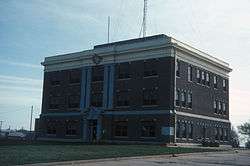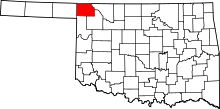Buffalo, Oklahoma
| Buffalo, Oklahoma | |
|---|---|
| Town | |
|
Harper County Courthouse (2007) | |
| Motto: "Proud History Bright Future" | |
 Location in Harper County and the state of Oklahoma. | |
| Coordinates: 36°50′13″N 99°37′44″W / 36.83694°N 99.62889°WCoordinates: 36°50′13″N 99°37′44″W / 36.83694°N 99.62889°W[1] | |
| Country | United States |
| State | Oklahoma |
| County | Harper |
| Government | |
| • Mayor | Lewis Carpenter |
| Area | |
| • Total | 0.8 sq mi (2.1 km2) |
| • Land | 0.8 sq mi (2.1 km2) |
| • Water | 0.0 sq mi (0.0 km2) |
| Elevation[1] | 1,814 ft (553 m) |
| Population (2010) | |
| • Total | 1,299 |
| • Density | 1,600/sq mi (620/km2) |
| Time zone | CST (UTC-6) |
| • Summer (DST) | CDT (UTC-5) |
| ZIP code | 73834 [2] |
| Area code | 580 |
| FIPS code | 40-09850 [1] |
| GNIS feature ID | 1090632 [1] |
| Website | buffalooklahoma.org |
Buffalo is a town and county seat of Harper County, Oklahoma, United States.[1] The population was 1,299 at the 2010 census. It was named after Buffalo Creek Valley, for which it is located.
History
In 1907, the town was "staked out" and a post office was established with the name Buffalo, which was derived from nearby Buffalo Creek. In 1908, a county seat election gave title to Buffalo and it was incorporated in the same year.[3] Buffalo's founders issued instructions for all buildings to be built of stone, thereby many of those structures survived the test of time.
The Harper County Journal, consolidated from the Buffalo Republican and the Harper County Democrat, has been published weekly since 1924. Other early newspapers included the Buffalo News, the Buffalo Bugle, the Buffalo Republican and the Post. The population peaked in 1960 at 1,618.
Geography
According to the United States Census Bureau, Buffalo has a total area of 0.8 square miles (2.1 km2), all land.[1] The city lies in the northwestern corner of Oklahoma at the Panhandle's eastern entrance, along U.S. Highway 183/64, 12 miles (19 km) south of the Kansas state line. It is 30 miles (48 km) northeast of the Texas state line and 174 miles (280 km) northwest of Oklahoma City.[3]
Doby Springs, a lake and park eight miles west and two miles north of Buffalo, is city-owned and provides a water supply.
Climate
| Climate data for Buffalo, Oklahoma | |||||||||||||
|---|---|---|---|---|---|---|---|---|---|---|---|---|---|
| Month | Jan | Feb | Mar | Apr | May | Jun | Jul | Aug | Sep | Oct | Nov | Dec | Year |
| Average high °F (°C) | 49.1 (9.5) |
55.3 (12.9) |
64.7 (18.2) |
75.4 (24.1) |
82.8 (28.2) |
91.9 (33.3) |
97.7 (36.5) |
96.0 (35.6) |
87.3 (30.7) |
77.4 (25.2) |
61.3 (16.3) |
51.0 (10.6) |
74.2 (23.4) |
| Average low °F (°C) | 20.2 (−6.6) |
24.6 (−4.1) |
33.3 (0.7) |
43.9 (6.6) |
53.6 (12) |
63.2 (17.3) |
68.6 (20.3) |
66.6 (19.2) |
58.5 (14.7) |
45.8 (7.7) |
32.9 (0.5) |
23.1 (−4.9) |
44.5 (6.9) |
| Average precipitation inches (mm) | 0.5 (13) |
1.0 (25) |
1.9 (48) |
2.4 (61) |
4.4 (112) |
4.0 (102) |
3.0 (76) |
3.5 (89) |
3.1 (79) |
1.9 (48) |
1.6 (41) |
0.8 (20) |
28.1 (714) |
| Source: Weatherbase.com [4] | |||||||||||||
Demographics
| Historical population | |||
|---|---|---|---|
| Census | Pop. | %± | |
| 1910 | 282 | — | |
| 1920 | 479 | 69.9% | |
| 1930 | 990 | 106.7% | |
| 1940 | 1,209 | 22.1% | |
| 1950 | 1,544 | 27.7% | |
| 1960 | 1,618 | 4.8% | |
| 1970 | 1,579 | −2.4% | |
| 1980 | 1,381 | −12.5% | |
| 1990 | 1,512 | 9.5% | |
| 2000 | 1,200 | −20.6% | |
| 2010 | 1,299 | 8.3% | |
| Est. 2015 | 1,311 | [5] | 0.9% |
| U.S. Decennial Census | |||
As of the census[6] of 2000, there were 1,200 people, 495 households, and 336 families residing in the town. The population density was 1,502.4 people per square mile (579.2/km²). There were 599 housing units at an average density of 750.0 per square mile (289.1/km²). The racial makeup of the town was 92.92% White, 0.08% African American, 1.17% Native American, 4.67% from other races, and 1.17% from two or more races. Hispanic or Latino of any race were 10.33% of the population.
There were 495 households out of which 28.9% had children under the age of 18 living with them, 56.0% were married couples living together, 8.7% had a female householder with no husband present, and 32.1% were non-families. 28.7% of all households were made up of individuals and 15.8% had someone living alone who was 65 years of age or older. The average household size was 2.34 and the average family size was 2.87.
In the town the population was spread out with 22.8% under the age of 18, 7.5% from 18 to 24, 22.8% from 25 to 44, 24.2% from 45 to 64, and 22.8% who were 65 years of age or older. The median age was 43 years. For every 100 females there were 91.4 males. For every 100 females age 18 and over, there were 92.5 males.
The median income for a household in the town was $30,433, and the median income for a family was $38,333. Males had a median income of $25,625 versus $20,515 for females. The per capita income for the town was $15,328. About 8.2% of families and 11.7% of the population were below the poverty line, including 18.1% of those under age 18 and 5.4% of those age 65 or over.
Education
Buffalo School District oversees primary and secondary education.
Media
Transportation
U.S. Route 64 goes through Buffalo. The Buffalo Municipal Airport (Oklahoma) is located north of Buffalo.
See also
References
- 1 2 3 4 5 6 Geographic Names Information System (GNIS) details for Buffalo, Oklahoma; United States Geological Survey (USGS); December 18, 1979.
- ↑ United States Postal Service (2012). "USPS - Look Up a ZIP Code". Retrieved 2012-02-15.
- 1 2 Bamburg, Maxine. "Buffalo," Encyclopedia of Oklahoma History and Culture. Archived June 8, 2009, at the Wayback Machine.
- ↑ "Historical Weather for Buffalo, Oklahoma, United States".
- ↑ "Annual Estimates of the Resident Population for Incorporated Places: April 1, 2010 to July 1, 2015". Retrieved July 2, 2016.
- ↑ "American FactFinder". United States Census Bureau. Archived from the original on 2013-09-11. Retrieved 2008-01-31.
External links
| Wikimedia Commons has media related to Buffalo, Oklahoma. |
- City of Buffalo
- Harper County Oklahoma Tourism Website
- Buffalo Public Schools
- Buffalo Theatre and Community Centre
- Encyclopedia of Oklahoma History and Culture - Buffalo

